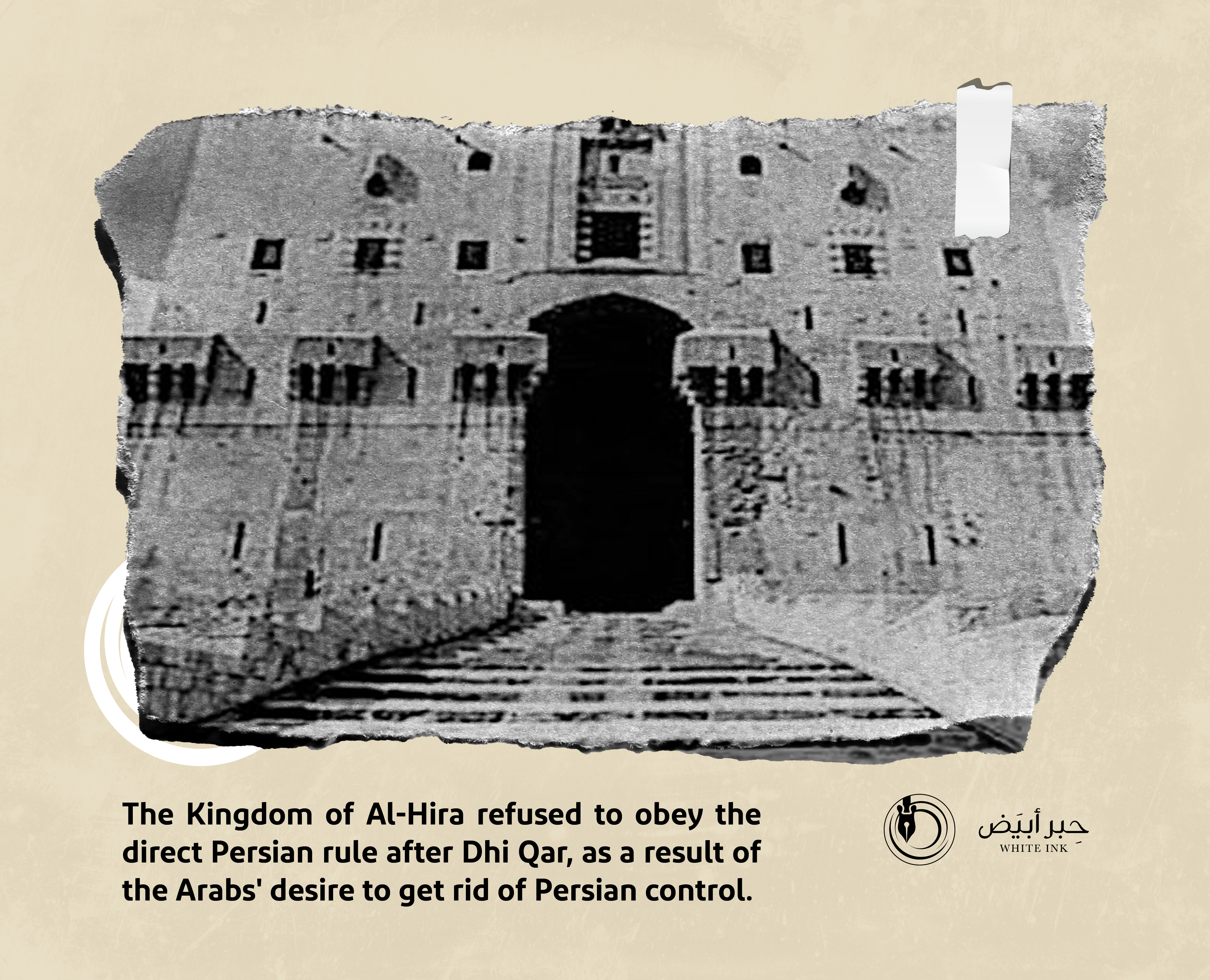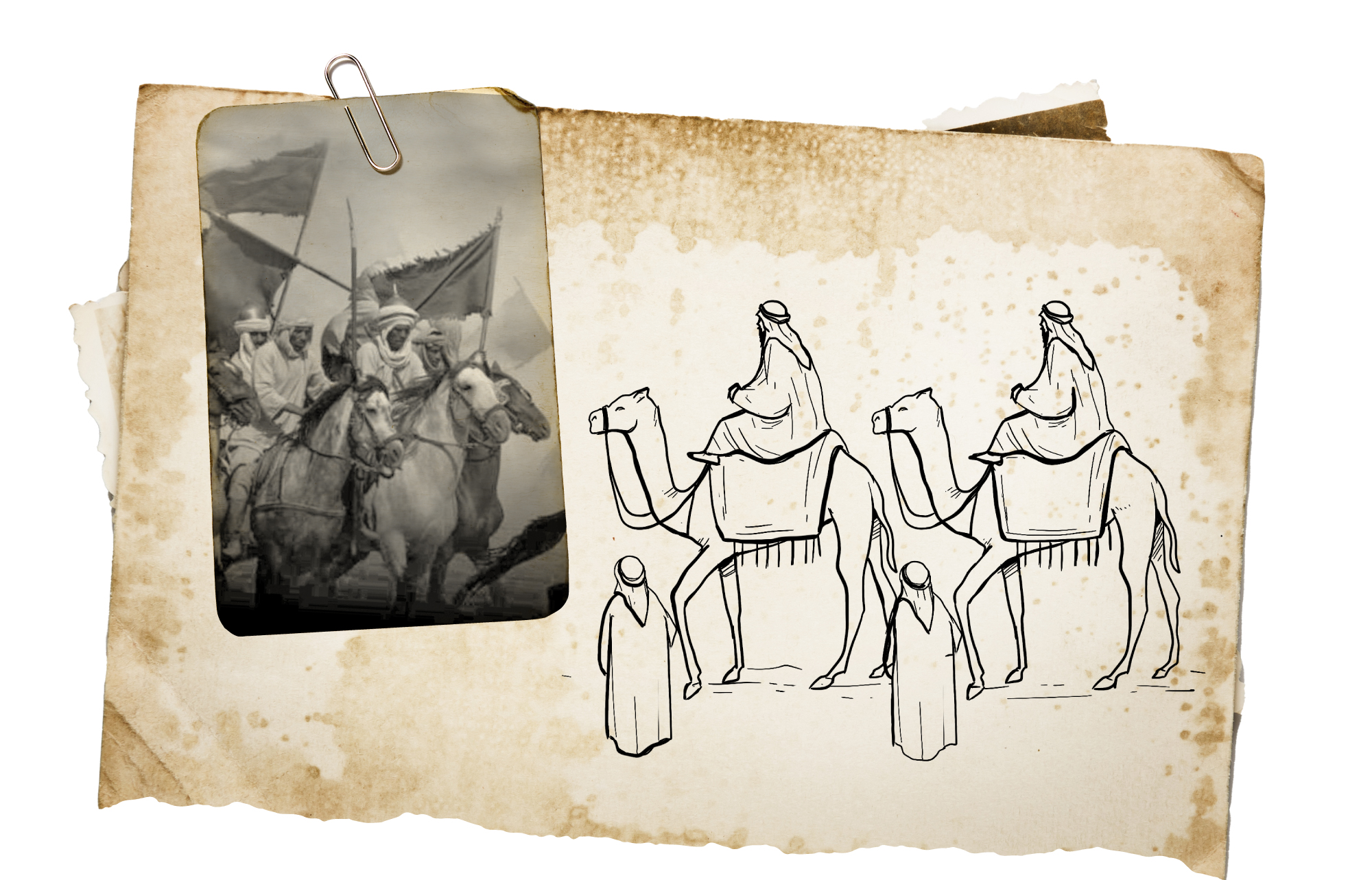
The historical and strategic formations after “Dhi Qar”
increased Arab confidence and raised the level of sense of strength in light of the nation's unity
The importance of studying the strategic environment that surrounded the battle of Dhi Qar is not limited to being an ordinary, abstract military confrontation that can be included in the tactical analysis of the battles, but rather considering its strong repercussions on the rise of the Arabs (the place of the emergence of Islam) to the position of sovereignty in the region, especially after Allah honored them with the religion of Islam and the last of the prophets.
Focusing on the battle of Dhi Qar is not a matter of intellectual luxury or mental comfort, but rather because of the lessons it contains that can be learned from one of the most prominent battles that drew a dividing line in the regional relations between the Arabs and the Persians.
Dhi Qar is an all-encompassing event that has a set of meanings and conclusions that can be considered a reference for every researcher in history, strategy or social relations alike.
In this regard, after we have presented the observation and analysis of the lessons that can be learned from the battle and the factors of the Arab victory over the Persians, we must complete the squares of the image by dismantling the post-Dhi Qar environment and its redrawing of powers in the region.
The ethnic superiority of the Persians made them not expect the outcome of a battle that would have a role in changing the strategic power in the region, especially with the entry of a new unified factor, the religion of Islam, which was a catalyst in confronting every ethnic regime that saw the elimination of the Arabs as an existential necessity.
After Khosrau had suffered a heavy and humiliating loss for him, his prestige and his army, he had no goal after this battle but to save his rule, as he was quick to isolate Iyas Ibn Qubaisa from the rule of Al-Hira and appointed a Persian ruler over it. He maneuvered to restore the Persian control to the degree it had before the battle.
It can be said that the victory of the Arabs in Dhi Qar was not only reflected in their sense of their strength when they united, but rather “the beginning of an era for the liberation of the Arabs, followed by a shock between the Persians, indicating the decline of their rule and their descent to the lowest level. The researcher will discover that one of the most important results of this battle is that fear was removed from the hearts of the Arabs, their morale was raised and the morale of the Persians was weakened”.
The battle of Dhi Qar will remain a turning point for extracting lessons and it could have inspired great strategists such as the French Ardan Dubeck who wrote a book called “The Art of Battle”. He stresses through this book that war is basically a war of will and that the one with strong and solid will is the one who succeeds and wins regardless of the balance of power.
In Dhi Qar, the Persians suffered their first defeat by the Arabs. “This was a motive that awakened the confidence of the Arabs, emboldened them, and prepared them for a close epic that history had prepared for them. History takes the wills into consideration, but it has its own will in the results, and the proof of that is that the day of Dhi Qar was a surprise for the Persians and the Arabs as well. It is not easy to determine which of the two surprises were more severe and greater”.
It can be asserted that the battle of Dhi Qar showed the Persians the cunning of the Arabs and their intelligence in managing battles and wars. It can also be a source of inspiration for the Arabs in the present time through the necessity of forgetting their disputes and the necessity of uniting them against the external enemy, especially when they realize that their existence and power are under threat. This sense of nationalism was clearly emerged in the battle of Dhi Qar. Abu Obadiah mentioned that about two hundred prisoners from Tamim were in Bakr Ibn Wael tribe. They said: “Let us fight with you, for we are defending ourselves”.
Since the magnanimity of the Arabs and their defense of their honor constituted an integral part of the main character of the Arabs, Dhi Qar was an Arab uprising against any insult to the honor of Arab women, as the Persians did not dare to attack Arab girls again after that.
These are lessons in war, maneuvering, tactics, strategy, Arab unity, and rising the meanings of honor. These lessons were shown to us by the battle of Dhi Qar, which we should carefully examine and contemplate.
It was the battle of Arab pride and the defense of personality that is based on honor and resistance.



- Khaled Al-Douri, The Arab Resistance to the Sassanid Influence in Al-Hira from 226AD to the Battle of Dhi Qar, Unpublished Master’s Thesis, College of Education, Tikrit University (2003).
- Abd Al-Wahhab Azzam, The Links between Arabs and Persians and Their literature in Pre-Islamic Times and Islam (Cairo: Hindawi Foundation, 2012).
- Homa Katouzian, The Persians: Iran in the Ancient, Medieval and Modern Times, translated by: Ahmed Hassan Al-Ma’ini (Beirut: Dar Jadawel, 2014).
- Jawad Ali, The Detailed History of the Arabs Before Islam, 4th Edition (Beirut: Dar Al-Saqi, 2001).
- Raif Khoury, With the Arabs in History and Legend (Cairo: Hindawy Foundation, 2019).
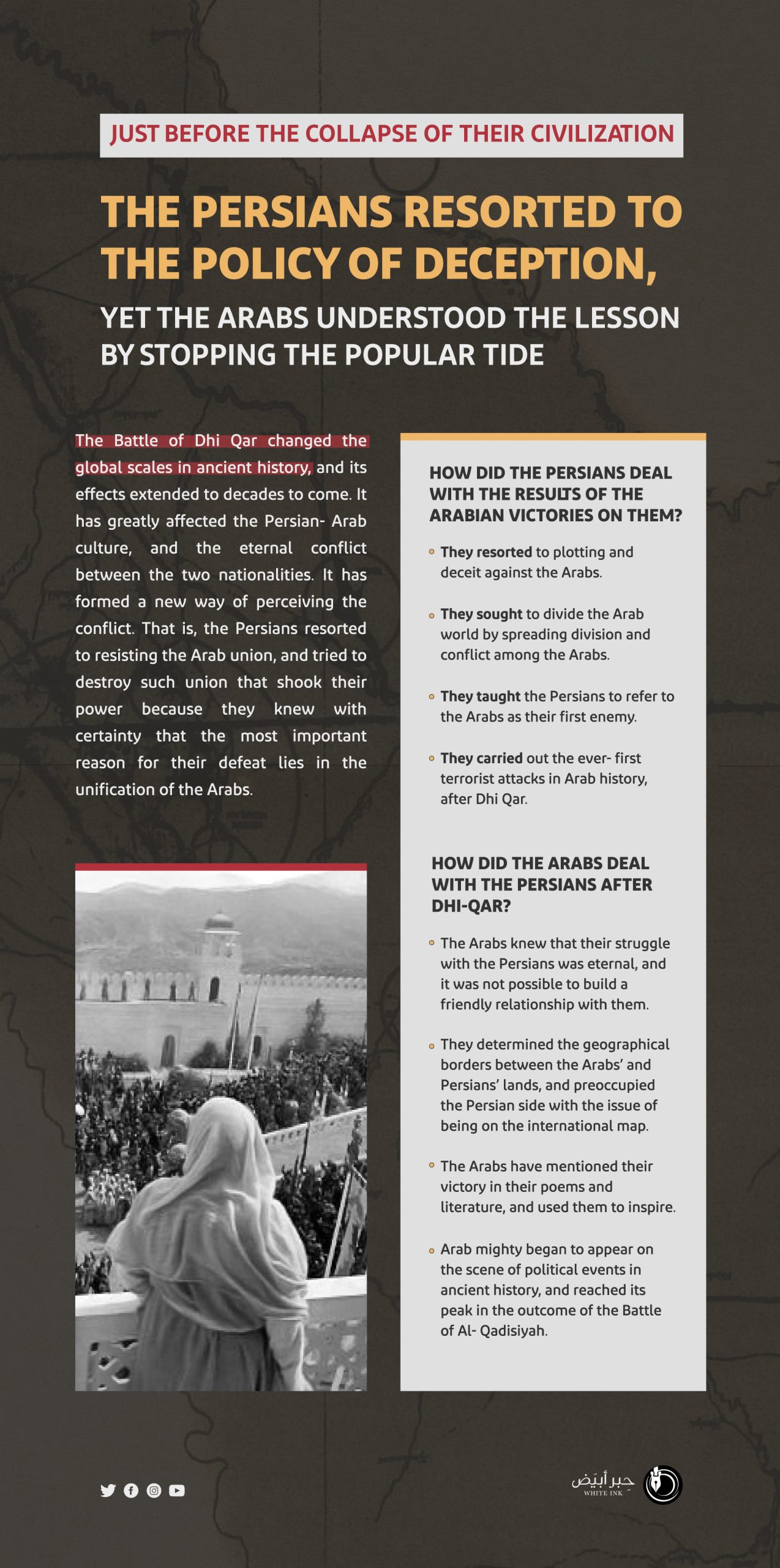
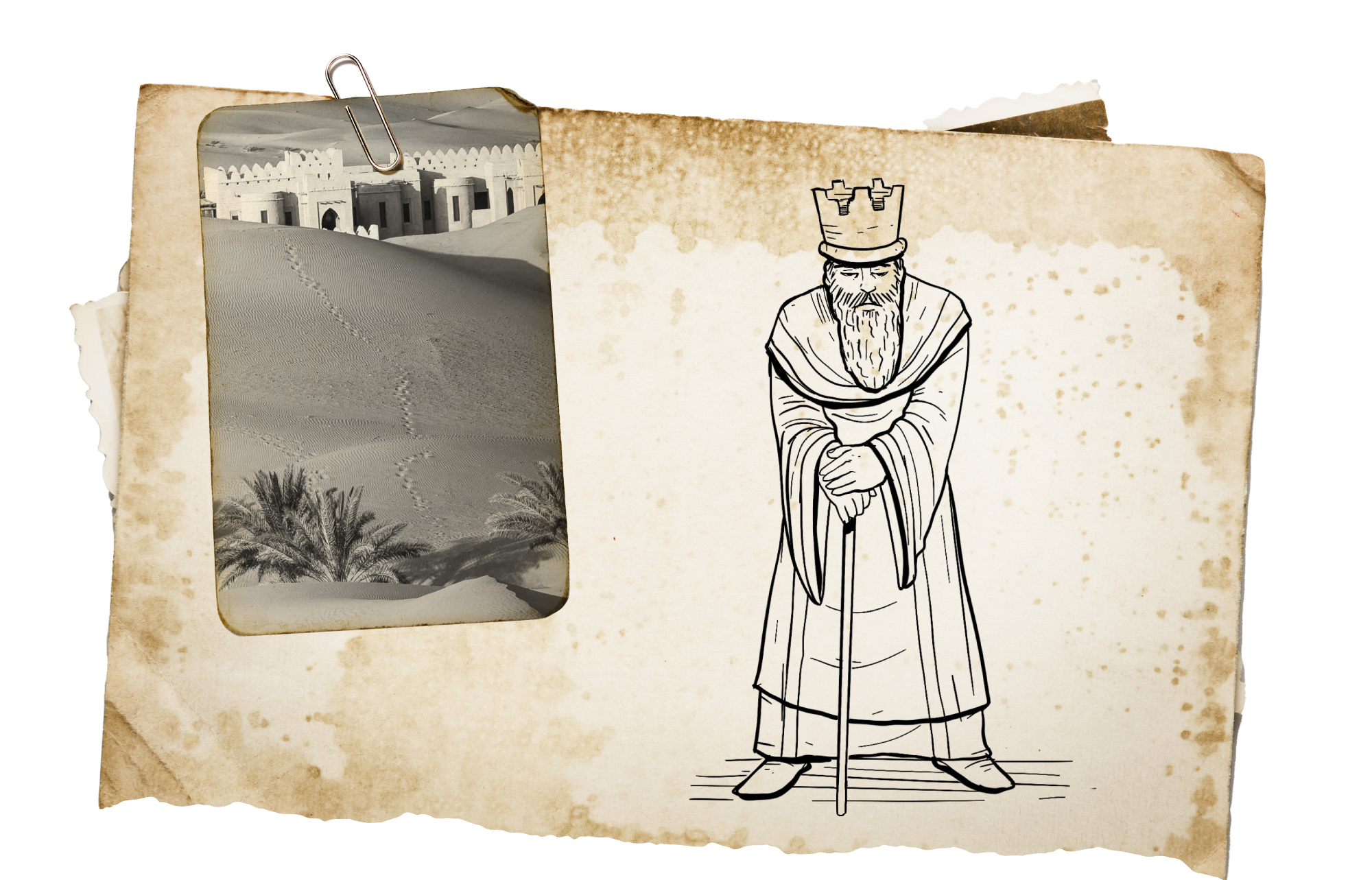
On a Day of Bravery and Dignity.
The Reverence of the Persian Khosrow Vanished under the Sands of the Arabian Desert
“Khosrow”, the Persian King, who was proud of his throne and Iwan would not have imagined that those Arabs coming from the middle of the desert could inflict a bitter defeat on him and his army. It was, rather, a historical disgrace that is still reverberated up to this day. Going back to that historical era to make a comparison between the Arab and Persian nations, we would find that the civilizational experiences and military capabilities of Arabs did not exceed the limits of their barren desert that neither had resources nor the minimum essentials of life. On the other hand, Persians lived with enormous resources due to their proximity to rivers and seas.
In a historical study prepared by Abdul- Manan Shafiq, titled “The Battle of Dhi Qar, a Historical Analytical Study”, in which he says about the reasons for the Arab victory in an unequal battle; when studying this battle, the reader feels confused when he knows that Bedouin Arabs were actually able to defeat the Sasanian state in this battle. He would also be astonished and stunned when he knows that Persia was the greatest state at that time as it has extended its dominant influence over a vast area of lands. It was in its very prime having power during the era of Khosrow Parviz who defeated the Byzantine state, achieved conquests on a large scale and called himself Parviz, which meant the Victorious one. On the contrary, Arabs were afraid of the Persian power at the time, so they were psychologically defeated, and they believed that they were inevitably vanquished. No better evidence to such state than the words of Hani bin Qabisa who, at first, suggested to his people to flee and save their skin in the desert. This also is proved by the wander of Al- Nu’aman bin Al-Mundhir about the Arabian tribes seeking for recourse, but no one accepted to support him. Tayy tribe even told him, were it not for your brother-in-law, we would have killed you. We are not willing to be hostile to Khosrow and we have no power against him. This shows that, on one hand, Arabs were psychologically defeated and were afraid of the brutality of Khosrow and his army. On the other hand, we find that there was a huge gap between the two sides regarding equipment and gear. In addition, there was a regular army against Irregular army. In spite of these harsh and inappropriate conditions, as well as the great contrast, the weaker side could achieve the magnificent victory and inflict an ignominious defeat on the Persians. This means that such victory neither came out of thin air nor was random. Rather, there was planning, reflection, reasons, and factors that led Arabs to victory and resulted in the defeat of Persians, the most important of which were two reasons:
1- The superior military planning and strategy implemented by Arabs before and during the battle, including: distributing the weapons of Al- Nu’aman bin Al-Mundhir, hastening to encounter the Persians, cutting the roads off, setting ambush against Persians, drawing water for half a month, incitement, encouragement, ideal leadership and other plans that helped Arabs very much to win the battle and defeat the Persians. In addition, there is no doubt that Persians also planned and set the necessary strategy, however, Arabs surpassed them in this regard in this battle.
2- Arabs fought this battle with unparalleled fortitude. They also fought desperately especially after they had known that, anyway, death was the fate awaiting for them because if they were left to flee to the desert, they would have died of hunger and thirst. On the other hand, if they surrendered to the Persians, they would have been killed while their women and children would have been taken captives. Thus, they were certain that death with dignity, bravery and honor in the battlefield is much better than death with humiliation, ignominy, degradation, and misguidance. Therefore, they joined their forces and defended themselves valiantly and won the battle.
In return, Persians were sure of victory over Arabs, but they were defeated because the battle was not a decisive fate for them. Thus, they neither exerted the effort that the Arabs exerted nor did they fight with fortitude. Therefore, they lost the battle.
“Dhi Qar” enhanced the status of Arabs and shook the Persian throne and influence. Rahaf Salam, researcher, gave a description in her published research on the impacts left by this war, saying, it made the borders of Sasanian state affiliated to Khosrow a target to the attack of the Arab tribes. Furthermore, such victory boosted the Arab morale and declined the Persian reverence in their eyes.
Khosrow Parviz did not accept the battle loss, so he burst with anger and immediately blamed someone else for the loss. It was no one but Iyas ibn Qabisa, Al- Hirah ruler, whom he promptly dismissed, as Persians considered him responsible for the defeat because he was the supreme commander of the army that fought the battle. However, Iyas escaped from him, as said by Arabs, as he separated from the battle when he realized the loss that his army had suffered. He went to Khosrow and deceitfully told him that Persians won that battle, fearing that Khosrow would dislocate his shoulder as he did before to the one who brought him bad news about it, then, he fled.
Iyas ibn Qabisa knew that he would be the first victim of the defeat incurred by Khosrow, therefore, he hurried to him before anyone saying, “We defeated Banu Bakr, and their allies, and we brought you their women”. Khosrow was pleased and ordered to give him a garment. Then, Iyas asked his permission to leave to visit his brother Qays ibn Qabisa whom he claimed was sick in Ayn Al- Tamr. Khosrow gave him the permission so he evaded capture. Then, a man from the people of Al- Hirah came to Khosrow while he was in Al- Khornaq Castle after he had known that Iyas preceded him to the king as he thought that Iyas told him of the Persian defeat. He entered to him and talked to him about the defeat, regression and capture of Persians. Khosrow ordered to immediately kill him. After that, Al- Hirah became directly ruled by the Persians after dismissing Iyas who deceived Khosrow.
Consequently, Persians directly ruled Al- Hirah and the Persian Azadhbih ibn Mahan was appointed as its ruler. However, he could not dominate the Persian influence whose status has been shaken after the defeat, neither could he restore the trust that once was between Al- Manathera and Khosrows, nor could he improve the relationship that has worsened between Arabs and Persians. Banu Bakr, who independently ruled Al- Bahrain, rebelled, then, they were followed by the tribes of the central Arabian Peninsula. This forced the Persians to return the rule of Al- Hirah to one of the sons of Al- Nu’aman, who was the arrogant Al-Mundhir, in an attempt to restore the pre- battle situation.
Persians were not able to regain their imperial reverence, they were given by Arabs, after Dhi Qar.

Khosrow could not restore the Persian reverence which they gained by their brutal ruling, their mastery of torturing, assaulting, and severely punishing their opponents. They even chased them to dislocate their shoulders. Such reverence vanished under the sand dunes and was blown away by the winds of the Arab bravery. Since poetry is the Arab Diwan (Arabic poetic literature) and their historical reference, Al- A’sha has proudly documented in his Mo’allaqa (one of the Hanging Odes) the results of that battle:
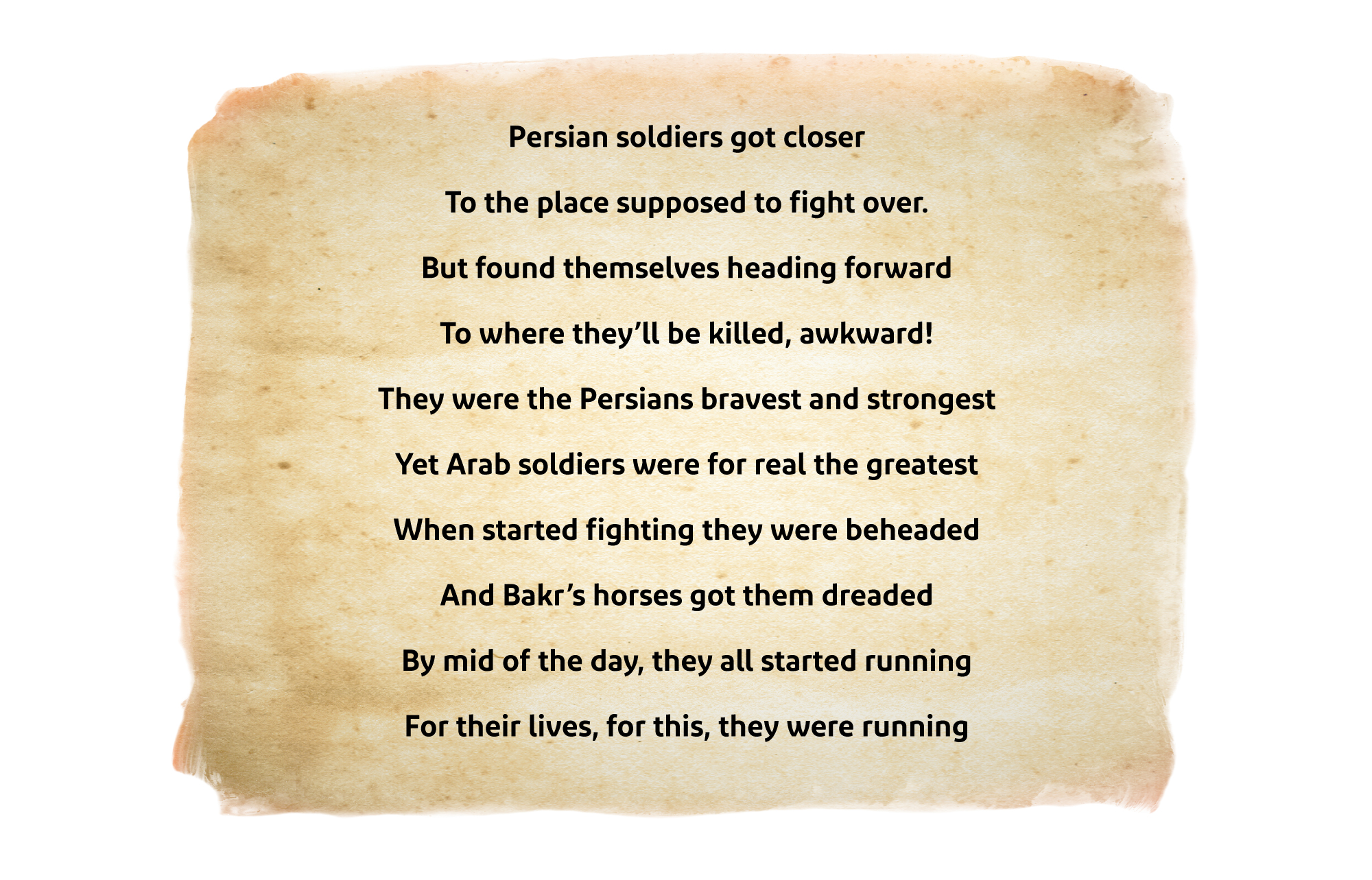


- Tawfiq Pro, The History of the Ancient Arabs ed. 2 (Beirut: Dar El- Fikr, 1996).
- Jawad Ali, Commentary on the History of the Arabs before Islam, ed. 4 (Beirut: Dar Al- Saqi, 2001).
- Khaled Al-Douri, The Arab Resistance to the Sasanian Influence in Al- Hira from 226 AD to the End of the battle of Dhi Qar, unpublished Master’s Thesis, College of Education, Tikrit University (2003).
- Abdul- Manan Shafiq, The Battle of Dhi Qar, a Historical Analytical Study (Mecca: Umm Al-Qura University, d.).
- Abdul- Wahhab Azzam, The links between the Arabs and the Persians and their Etiquette in the Pre- Islamic Era and Islam (Cairo: Hindawi Foundation, 2012).
- Raif Khoury, With the Arabs: In History and Legend (Cairo: Hindawi Foundation, 2019).
- Homa Katouzian, The Persians: Ancient, Mediaeval and Modern Iran, translated by: Ahmad Hasan Al- Ma’ini (Beirut: Dar Al- Jadawel, 2014).
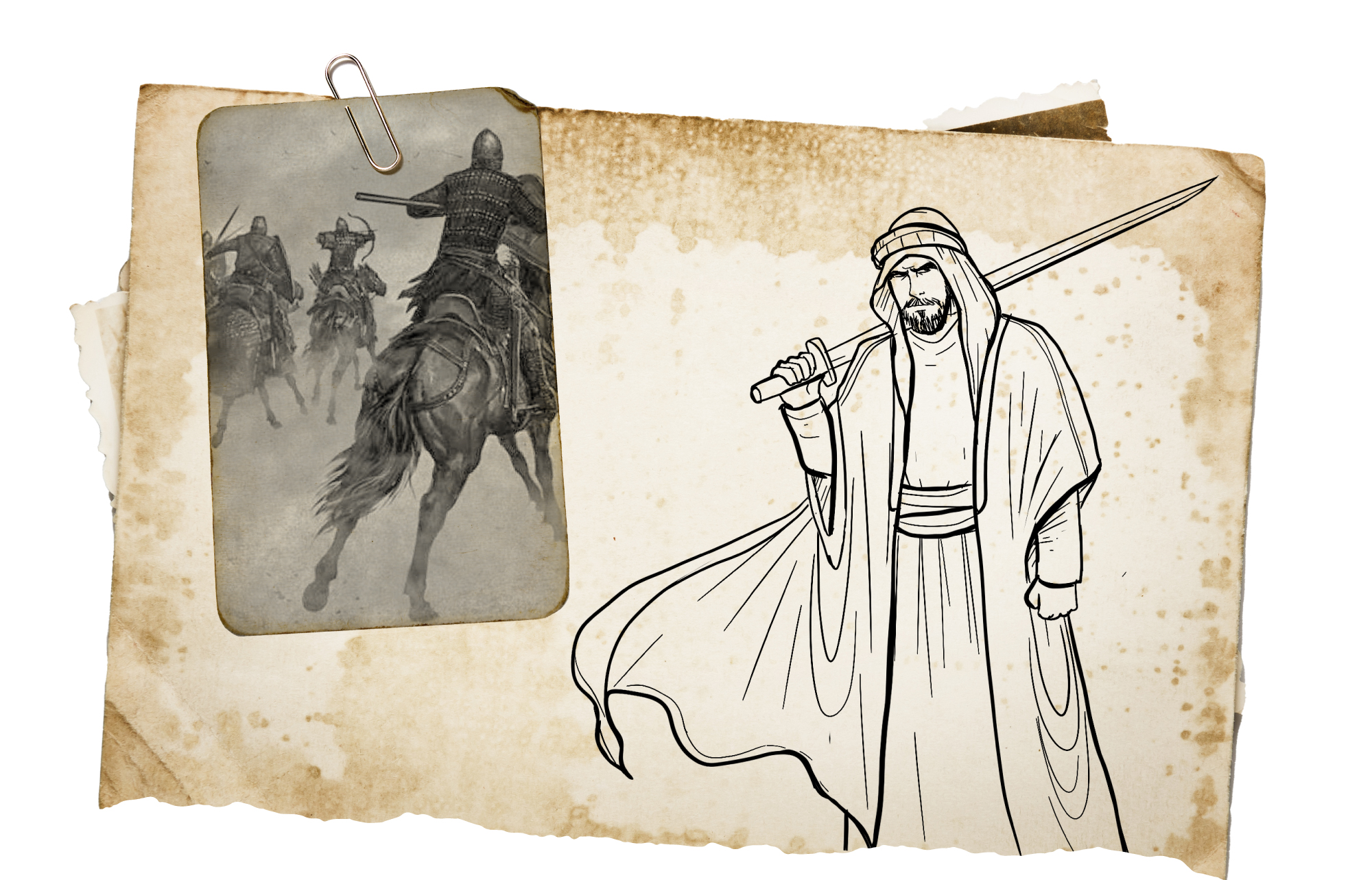
Dhi Qar
A battle that led the Persians to hide behind populism and heresy and practice intrigues and conspiracies
The Battle of Dhi Qar was a turning point between the Arab tribes, especially Bakr Ibn Wael tribe and those who allied with it, which suffered greatly from the domination of the Sassanid Empire and its tyranny for many years over its position and capabilities, and even over its religious beliefs. The Persians made Arab tribes fuel for the international conflict between the Persian and the Roman empires by creating an Arab province that protected the frontiers of the great power. Despite the preference and relative freedom given to some of the princes of the Arab Kingdom of Al-Hira by Khosrau, their prevailing view of the Arabs was a condescending and inferior view and that they were followers, subjects and tools used in events, crises and times of need only.
The importance of Dhi Qar lies in its national manifestations. For the first time in history, the Arabs dared to meet the Persians in a great open battle, and their morale strengthened. Although a number of Arab tribes were loyal to the Persians, their feelings were with the Arabs. This is evidenced when Iyad tribe retreated from helping the Persian army at the decisive time of the battle, and Banu Al-Sukoon and some of Banu Tamim tribes joined with Bakr Ibn Wael and Shayban tribes against the Persians.
The Arabs immortalized their victory over the Persians in historical and literary memory.

The Arabs immortalized their great victory over the Persians with pride in many poems in the pre-Islamic era and in Islam. After Al-A’sha’s poem, there is a poem by Abu Tammam praising Abu Dulaf Al-Ijli:
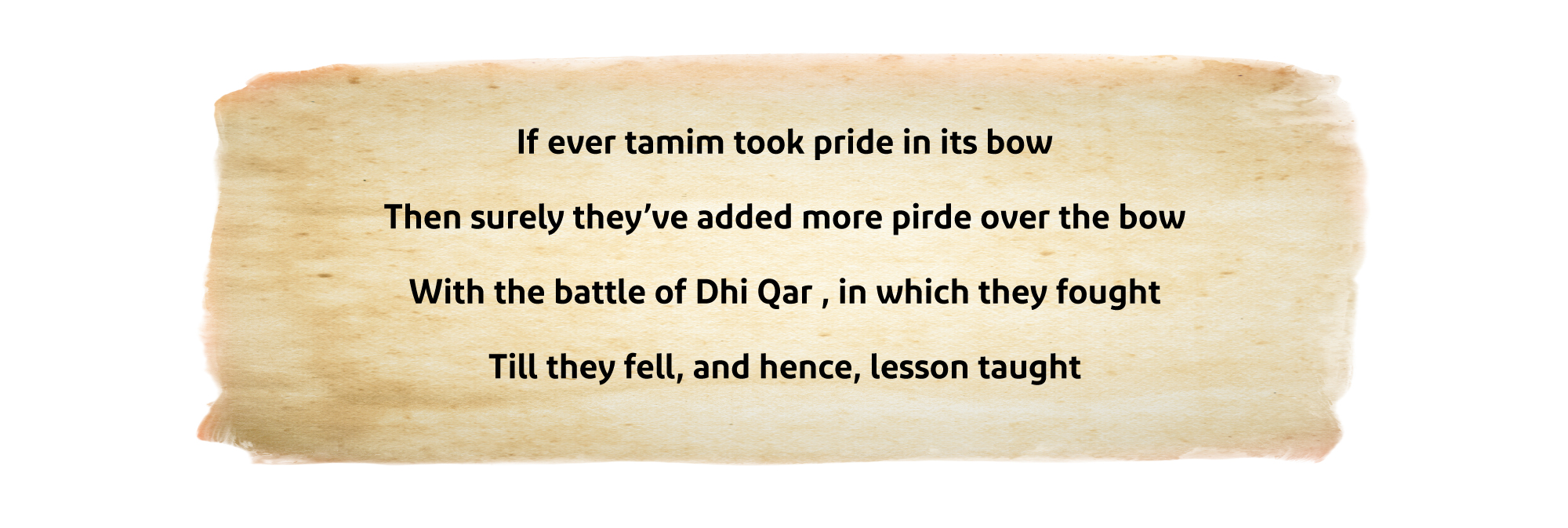
After Dhi Qar, the Arabs were no longer afraid and their morale rose until they were able to threaten the borders of the Sassanid Empire. The effects of the eternal battle were reflected on the increase of unity and cohesion among the Arab tribes for the first time against the Magian Persian enemy with all strength and composure. The defeat of the Persians was a painful blow to Khosrau, who was unable to regain his prestige again on the Arabian Peninsula, which was able to unite the tribes and settle in Bahrain. The Arabs were no longer afraid of the Persians as they used to. Perhaps this great defeat that the Persians received was for a purpose that Allah knows. Who examines the date of the battle, according to what many of the chroniclers mentioned that it took place shortly before the Prophet Muhammad, may Allah’s prayers and peace be upon him, was sent, and this raises the question of the timing of that battle? There is no doubt that the Arabs were waiting for a great matter, a great event, and a great responsibility that was placed upon them when they entered Islam, which is to inform Islam to the world after Allah Almighty preferred them over all the nations, and on the other hand, so that there would be no prestige for the Persians and their empire as it was. Whoever reads the biographies of the Companions is fully aware of how this prestige was stripped from the Persians, and that one of the results of the Battle of Dhi Qar was that it paved the way for a new beginning and a starting point for the battles of the Islamic conquest of Persia since the era of the Rightly-Guided Caliph Abu Bakr Al-Siddiq, may Allah be pleased with him, and under the leadership of the great companion Khalid Ibn Al-Walid until the conquest of Iraq. Khalid Ibn Al-Walid turned to the Levant Front to fight the Romans, but the Persian raids on Iraq continued until they recovered a large part of it, so the Muslims returned to fighting the Persians under the leadership of Saad Ibn Abi Waqqas. The prestige of the Persians was erased in the Battle of Al-Qadisiyyah, and the Persians lost the western part of their empire, but the Persian raids did not stop. Caliph Umar Ibn Al-Khattab decided to focus the Islamic military efforts on the Persians after the Battle of Al-Qadisiyyah until they subjugated the entire Persian Empire in less than ten years. That was the end of the Persian Sassanid myth, which continued to terrorize the ancient world, including the Romans, Greeks, Arabs, and others.
It is inevitable that the battle of Dhi Qar, with its achieved results and its wide impact, forever destroyed the Persian Magian pride that had been hiding behind populism, heresy and other false claims. Now, they are practicing intrigues and conspiracies against the Arabs and Islam in twisted ways because they are unable to confront directly again.


- Tawfiq Berro, The Ancient History of the Arabs, 2nd Edition (Beirut: Dar Al-Fikr, 1996).
- Elsayed Abdel Aziz Salem, History of the Arabs in the Pre-Islamic Era (Beirut: Dar Al-Nahda Al-Arabiya for Printing and Publishing).
- Lotfy Abd Al-Wahhab Yehia, The Arabs in Antiquity (Alexandria: Dar Al-Marefa Al-Jami’iyya, 1996).
- Muhammad Suhail Taqqosh, History of the Arabs before Islam (Beirut: Dar Al-Nafa’is, 2009).
- Yaqout Al-Hamawy, Lexicon of Countries (Beirut: Dar Sader, 1957).




